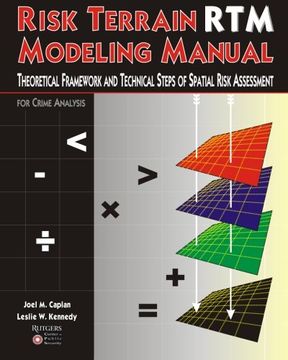Share
Risk Terrain Modeling Manual: Theoretical Framework and Technical Steps of Spatial Risk Assessment for Crime Analysis
Leslie W. Kennedy Ph. D.
(Author)
·
Joel M. Caplan Ph. D.
(Author)
·
Createspace Independent Publishing Platform
· Paperback
Risk Terrain Modeling Manual: Theoretical Framework and Technical Steps of Spatial Risk Assessment for Crime Analysis - Kennedy Ph. D., Leslie W. ; Caplan Ph. D., Joel M.
Choose the list to add your product or create one New List
✓ Product added successfully to the Wishlist.
Go to My Wishlists
Origin: U.S.A.
(Import costs included in the price)
It will be shipped from our warehouse between
Wednesday, June 26 and
Friday, July 12.
You will receive it anywhere in United Kingdom between 1 and 3 business days after shipment.
Synopsis "Risk Terrain Modeling Manual: Theoretical Framework and Technical Steps of Spatial Risk Assessment for Crime Analysis"
RISK TERRAIN MODELING (RTM) is an approach to risk assessment that standardizes risk factors to common geographic units over a continuous surface. Separate map layers representing the presence, absence, or intensity of each risk factor at every place throughout a terrain is created in a Geographic Information System (GIS), and then all risk map layers are combined to produce a composite "risk terrain" map with attribute values that account for all risk factors at every location throughout the geography. RTM aids in strategic decision-making and tactical action by showing where conditions are ripe for events to occur in the future. This manual is offered as a primer on risk in the criminal event and demonstrates effective ways to apply RTM to crime analysis and policing operations. It begins with a review of the RTM approach to spatial risk assessment and presents a short overview of the theoretical underpinnings of criminological theory that have addressed the social and environmental factors that contribute to crime patterns, hotspots, and risk terrains. The second part details the technical steps for analysts to take in using ArcGIS software to develop risk terrain maps. The third and final part presents ideas of how RTM works in strategic and tactical decision-making, particularly within the context of the ACTION model for risk-based intelligence-led policing. With this manual, analysts can produce risk terrain maps that give actionable meaning to the relationships that exist between place-based indicators and crime outcomes. Planners can use this approach to develop strategic models to forecast where crime problems are likely to emerge and to engage in steps that might reduce risks of crime occurring in the future.
- 0% (0)
- 0% (0)
- 0% (0)
- 0% (0)
- 0% (0)
All books in our catalog are Original.
The book is written in English.
The binding of this edition is Paperback.
✓ Producto agregado correctamente al carro, Ir a Pagar.

